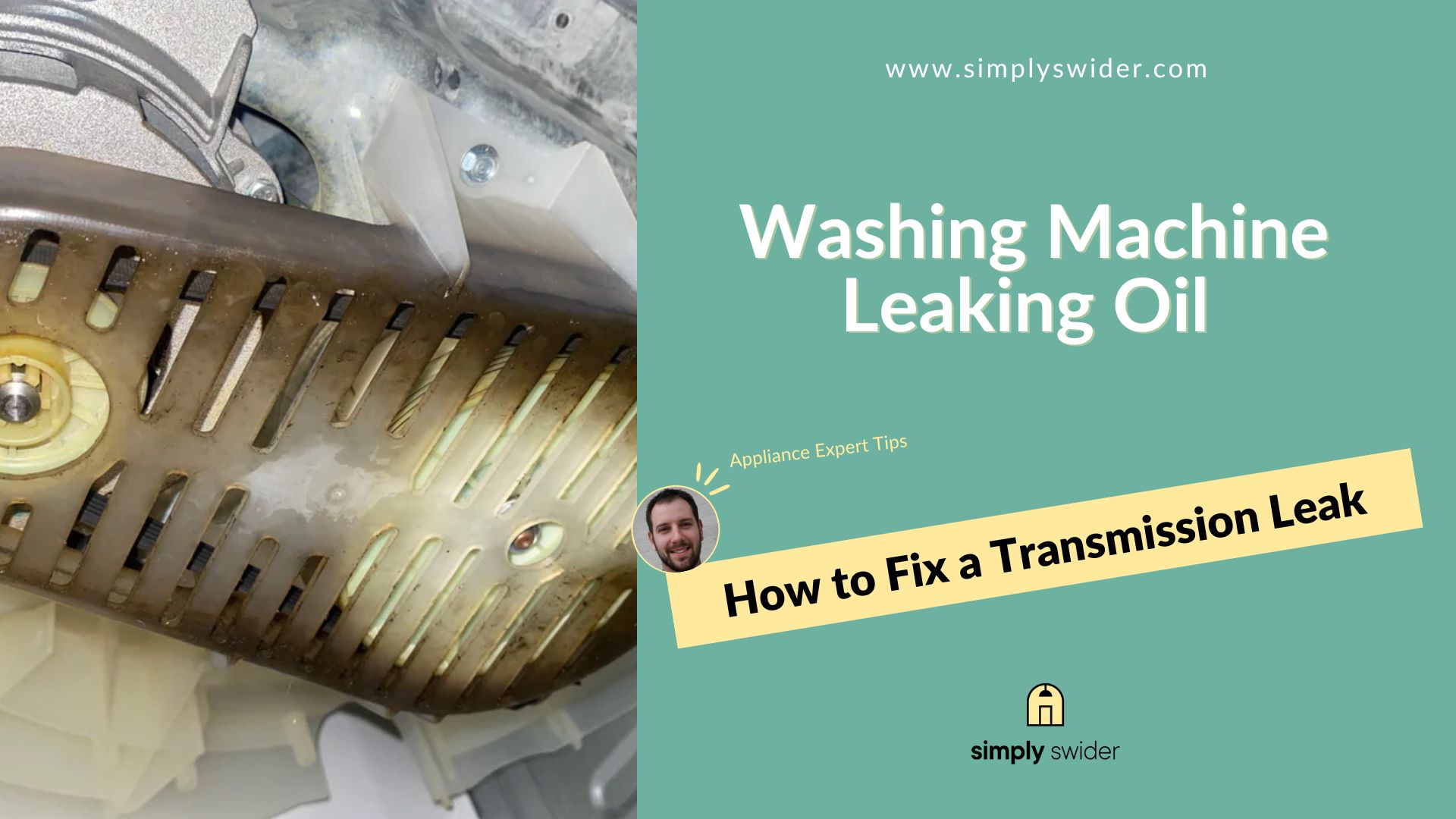In over a decade as an appliance technician, I’ve faced a myriad of washer issues. Yet, one that stands out is the perplexing oil leak.
You might wonder why.
It’s straightforward, here’s typically a singular culprit – the transmission/gear case.
Yet, many homeowners dread this, believing an oil leak signifies the final chapter for their washer.
Here’s the truth:
It doesn’t have to be.
For this guide, I’ve collaborated with Ian Cox, an esteemed repair technician from the beautiful Savannah, Georgia. Together, we’ll demystify the process, helping you address a transmission oil leak without a hefty bill.
Ready? Let’s dive in.
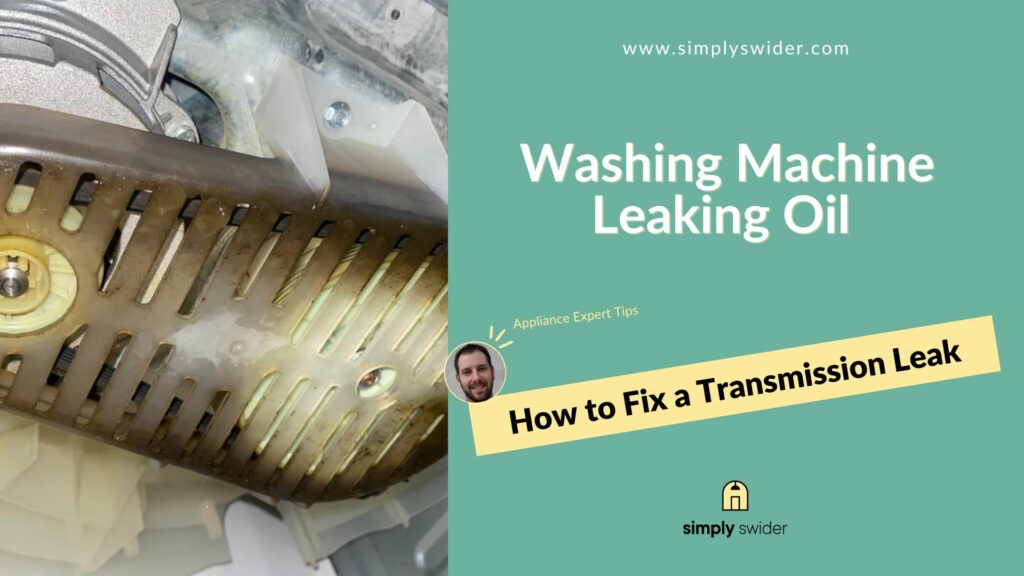
Table of Contents
What Causes a Washing Machine to Leak Oil?
If you’ve got oil pooling under your washing machine, it’s likely your transmission is the culprit. How sure am I? From years on the job, I’d say there’s a 99% chance. The transmission is the only component that holds oil.
Here’s the kicker:
If you notice that the oil is also getting into the tub, your tub seal is likely compromised.
Now, hold on:
Before you grab your toolbox and start taking the washer apart, verify the type of leak you’re dealing with. Trust me, I’ve seen folks dismantle their machines only to find it was just water.
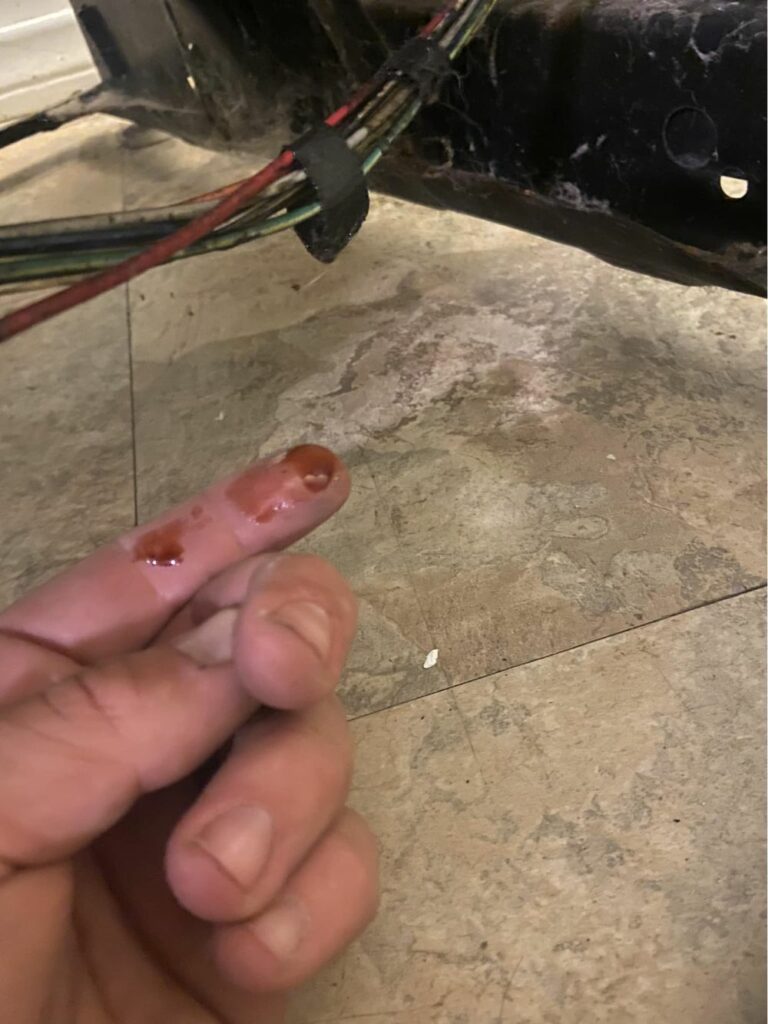
So, what’s the game plan?
I’ve summarized a quick table below to help you distinguish an oil leak from a water or grease leak. Trust this guide – it’s built on years of hands-on experience.
| Property | Water | Oil (from transmission) | Grease (from bearings) |
|---|---|---|---|
| Appearance | Clear | Clear to amber when new. Can turn brown/black over time | Thicker, can be white, yellowish, or dark. |
| Touch/Feel | Evaporates quickly, not slick. | Slick, smooth texture; leaves a residue. | Thick and viscous. It stays on the skin. |
| Smell | No distinct odor. | Distinct odor. Pungent if old or burnt. | A distinct, sometimes more metallic or chemical smell |
| Consistency | Thin and watery | Liquid, less viscous than grease | Thick. Can become firmer in cold temperatures |
| Absorbency Test | Makes the material uniformly wet. Dries without stain. | Leaves a translucent stain. | Leaves a consistent, thicker stain. |
Understanding the Causes and Solutions
1. Worn-Out Oil Seal on the Transmission (Gearcase)
| Part | Transmission Transmission oil seal |
| Location | Beneath the tub |
| Ease of troubleshooting | Hard |
| Replacement cost | Transmission $200-$500 Oil seal – $10-$50 |
| Repairable | Transmission – Yes Oil seal – No |
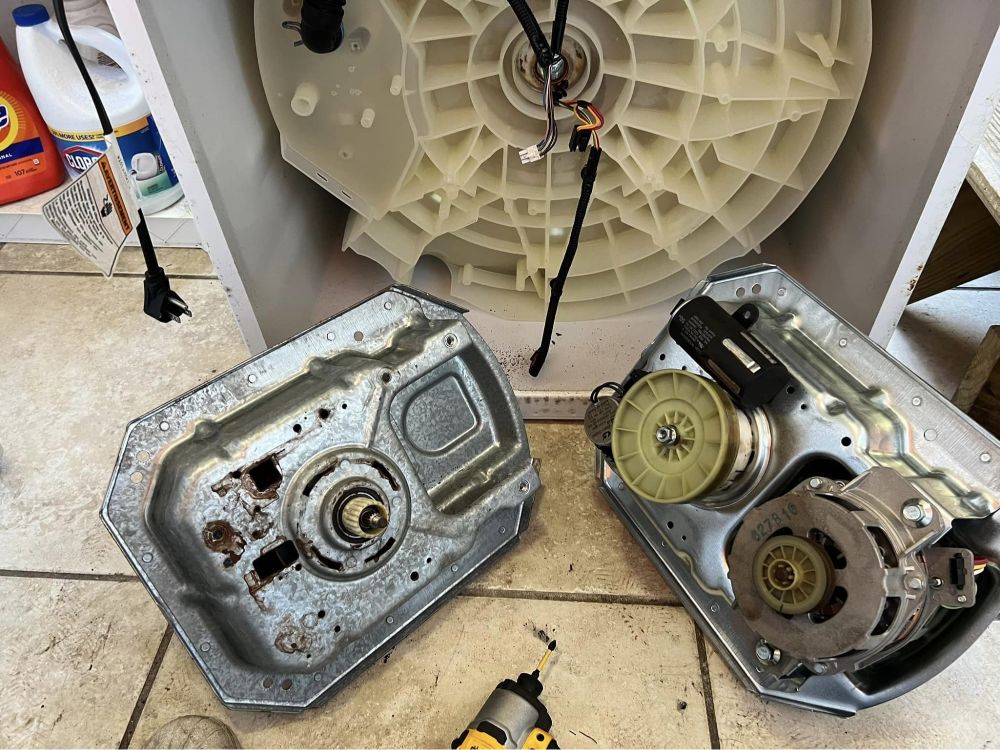
Problem:
When I sat down with Ian, my first question was about the top culprit behind these oil leaks, based on his hands-on experience.
Unsurprisingly, he pointed straight to the transmission, or what repair techs call the tranny. If you have the standard top-load washing machine with an agitator, it has a transmission in it.
Just so you know:
Front-loaders and high-efficiency top-loaders don’t have a transmission. Instead, the motor is connected directly to the tub.
As Ian explains, “The transmission role is to transform the motor’s rotational energy into the varied movements needed for both the agitation and spinning cycles.”
Note:
The transmission is also what’s called the gear case. Why? Well, inside the transmission is a set of plastic gears and oil for lubrication.
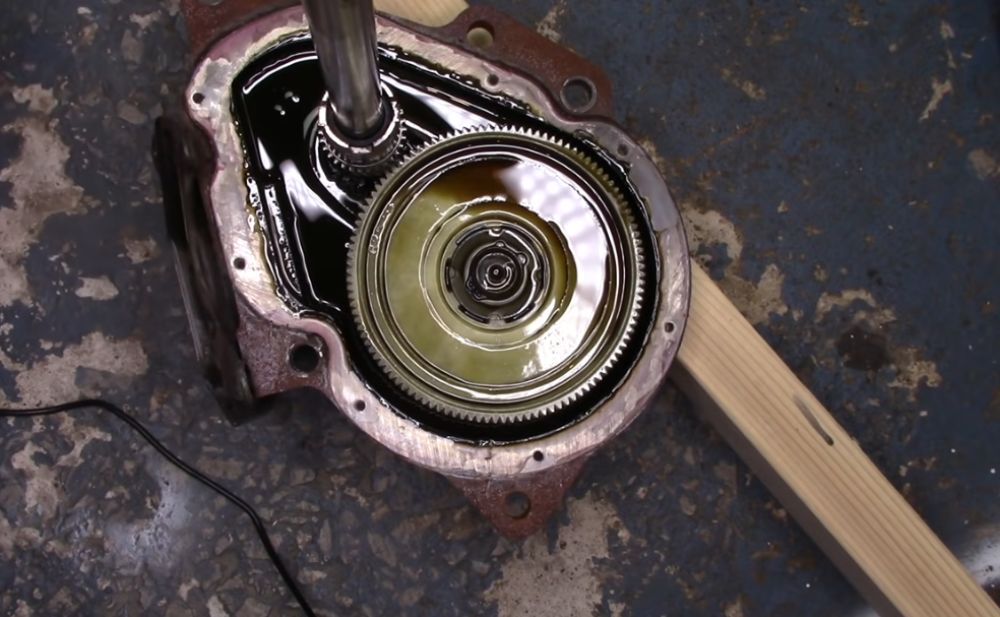
Sometimes, the oil inside the gear case may find its way out, and that’s what ends up on the floor. This usually happens when the oil seal on the transmission wears out or is damaged.
According to Ian, “When the leaking oil comes into contact with moving components like the drive belt, splutch cam, or shift actuator, it can cause unusual noises.”
To fix this problem, you’ll need to locate the transmission oil seal and replace it. But before that, I recommend assessing the leak.
Identification:
First things first, gently tip the washer on its back to get a good view of the bottom.
“The first telltale sign that the leak is coming from the gear case is if there is oil all over the components below it. That’s the motor, drive belt, and pulleys,” Ian says.
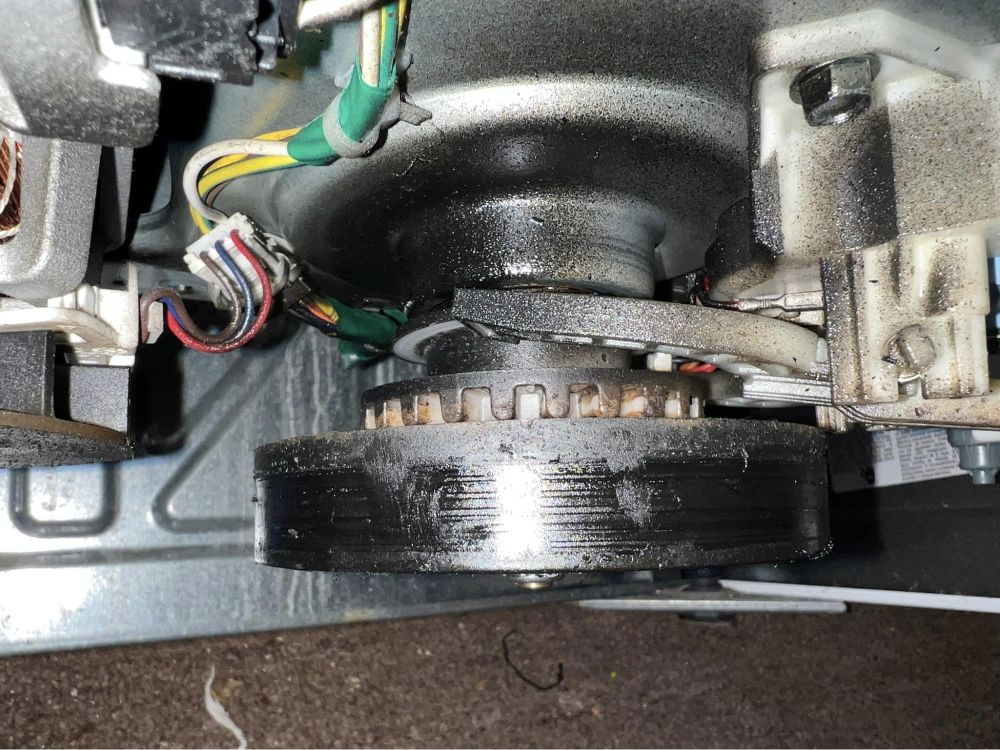
If you have confirmed the leak, it’s time to get working. The second step is to locate the transmission seal. On most transmissions, it’s usually located on the side. Be forewarned – this task can be a tad time-consuming and might call for a few specialized tools.
Here is how to inspect and replace a faulty transmission oil seal:
- Step 1: Safety first: When the washer is upright, unplug it from the power outlet and also turn off the water supplies.
- Step 2: Grab your socket with an extension and unscrew the agitator bolt. Remove the drive block too.
- Step 3: Use a tub nut wrench to unscrew the inner tub nut and then lift it out. If you don’t have a tub wrench, use a strap wrench.
- Step 4: Now move to the bottom. Here, you’ll need to tip the washer on its back to get a good view.
- Step 5: Start by removing the belt cover and then the drive belt.
- Step 6: Next, unscrew the nuts securing the motor. Then detach both the shift actuator and capacitor from it.
- Step 7: Remove the nuts securing the two pulleys, and then detach the splutch cam.
- Step 8: Finally, with the bolts unscrewed, you’re ready to pull the transmission out of the washer body.
Solution:
Alright, with the transmission out, let’s get down to the replacement.
First order of the day? To assess the leak. This involves determining how much oil has leaked by looking at the surroundings.
According to Ian, “If the transmission has lost a lot of oil, you will need to top it up to compensate for the loss. On the flip side, if it’s just a tiny spill, there’s no need to add more.”
As Ian advises, “You should top up the oil just before replacing the oil seal.”
Now:
To get a good gauge, take a look at the floor and all components below the transmission. If it looks like they’ve all had an oil bath, then yeah, you’ve lost quite a bit.
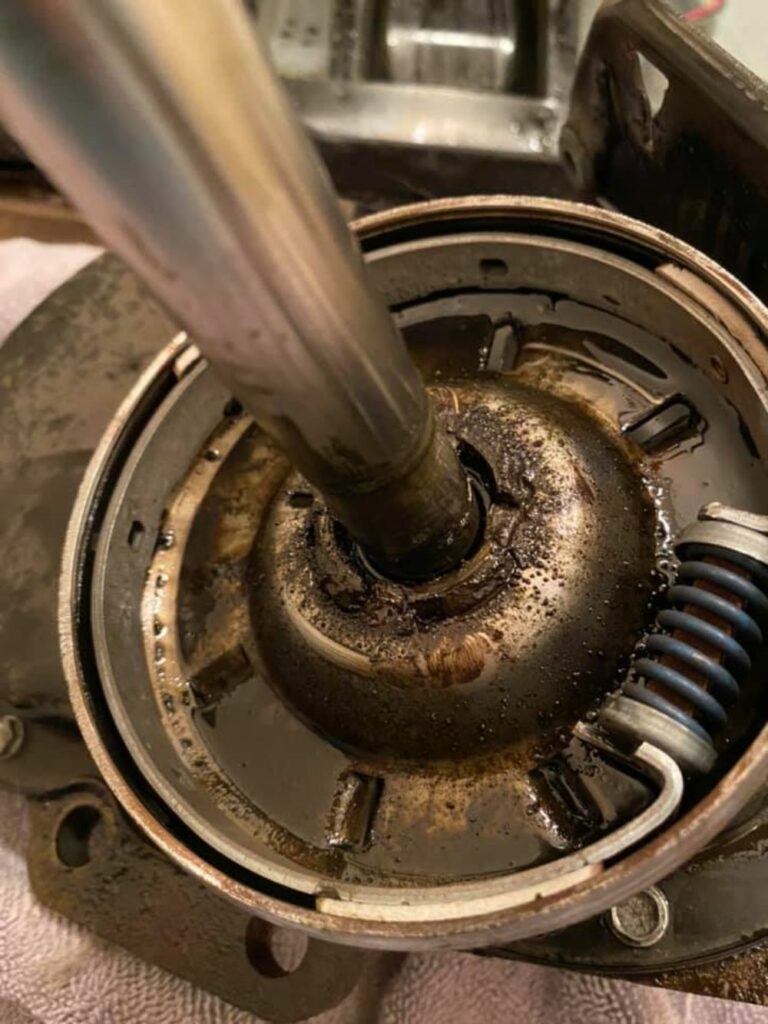
Next:
Use a flathead screwdriver or your fingers to pop off the motor coupling. This will grant you VIP access to the transmission seal.
A heads up:
The area around the seal will be messy since, well, that’s where the leak is originating. At this point, you will need a replacement transmission seal.
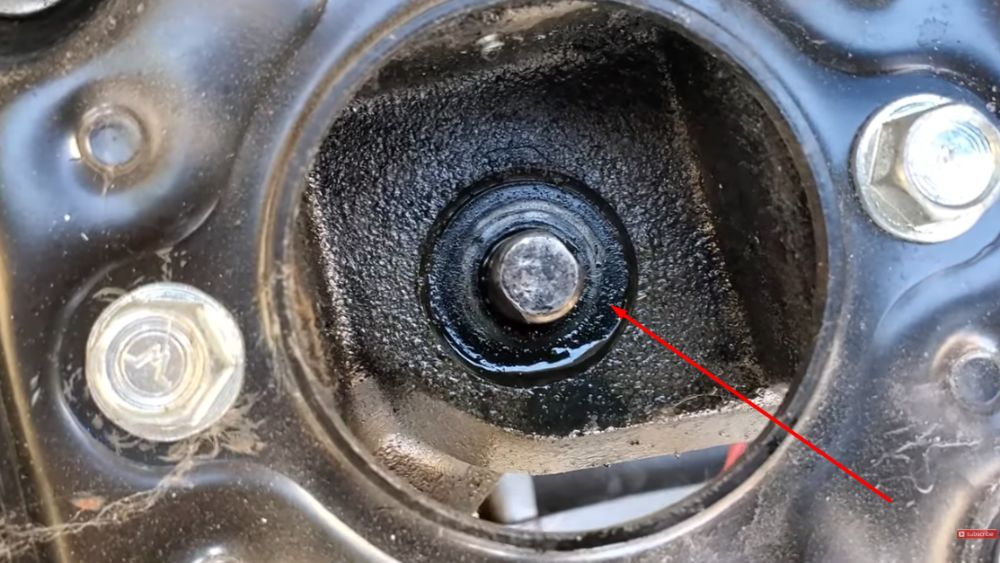
Now:
Grab that screwdriver and pry the old seal out. It might be hard to get it when you start. Keep at it, and you’ll snag it. Once it’s out, give the area a wipe-down with a paper towel.
Moving on:
Before you pop in the new seal, smear some grease around the opening. Next, align the seal on the opening and give it a gentle nudge with your fingers, ensuring it’s sitting just right.
Secondly:
Push it down, and then use a socket and mullet to drive it home.
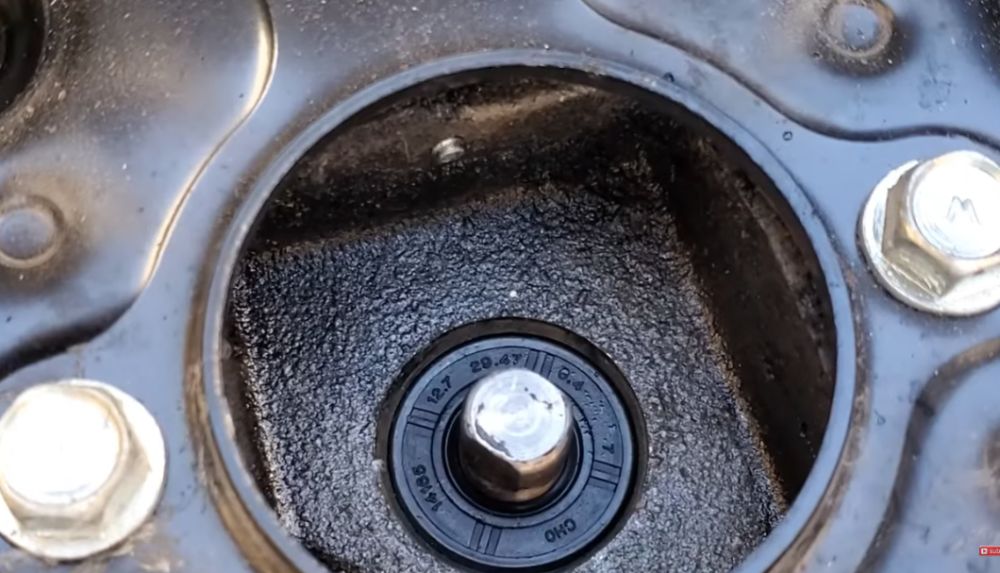
By the way:
If you’re feeling adventurous, you can disassemble the whole gear case, clean it up using kerosene, and then fill it up with oil.
To wrap it all up:
Reassemble all those bits and pieces and give your washer a trial run.
Note:
This process may differ depending on the transmission design, for instance, on this Whirlpool washer.
A golden nugget from Ian: “Every time I’m replacing the tub seal, I also replace the motor coupler and the tub seal. Trust me, it saves future headaches.”
Look, I won’t sugarcoat it:
Taking apart the whole washer is no joke. If this feels a tad out of your comfort zone, there’s no shame in calling in a pro.
Another route to consider? Swapping out the entire transmission. Just keep in mind that they don’t come cheap.
Now:
If you’re leaning towards replacing the transmission, here’s Ian’s savvy tip: “Check on eBay or Facebook Marketplace. Sometimes luck may be on your side, and you stumble upon a sweet deal.”
Note:
Some brands, like GE, suggest that the only fix for an oil leak is swapping the whole transmission. Which is just a fancy way of saying, “Buy a new GE washer.”
Finally:
For the DIY warriors among us who are always itching for the next challenge, Ian has one for you. “Another unpopular fix to a leaking transmission is replacing the oil with grease. However, this is a challenging and risky project.”
Why Is My Washing Machine Leaking Oil into the Tub?
Now:
If your washer is leaking oil inside the tub, you are facing double trouble. A faulty gear case and a worn-out tub seal.
Tub Seal
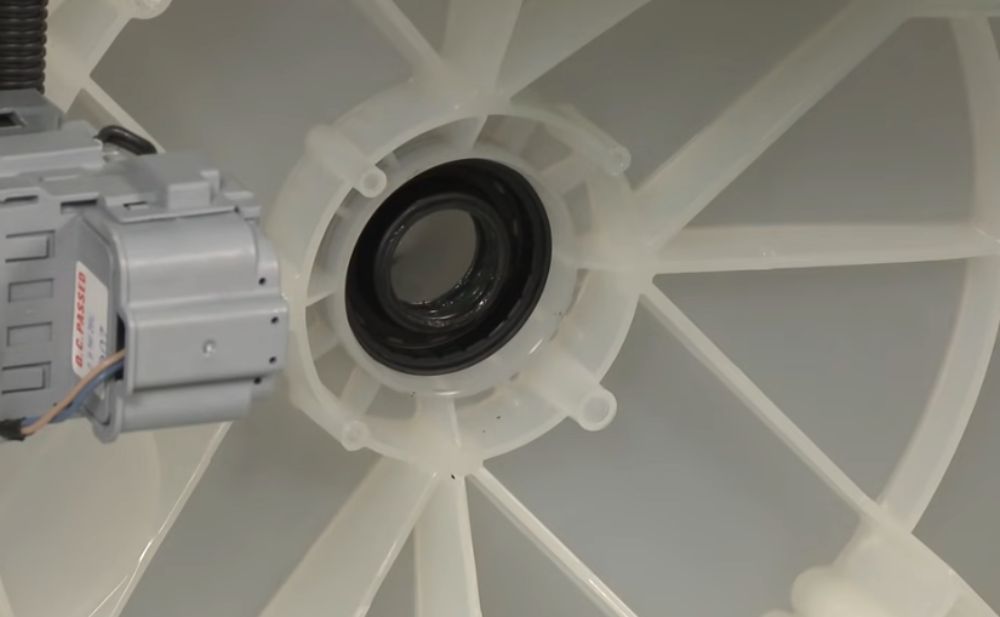
Now:
The tub seal acts as a barrier between the tubs and the transmission. When this seal is worn out, it no longer provides a tight barrier between the transmission and the water-filled tub.
Once the tub seal is compromised, and if the transmission seal is also leaking, the oil from the transmission can move upward into the tub.
But how?
Well, as the drum rotates, the movements can push the oil up through the damaged seal into the tub, sometimes causing black flakes.
Case in point:
I came across this user on Facebook whose Maytag washer was oozing oil from the agitator base.
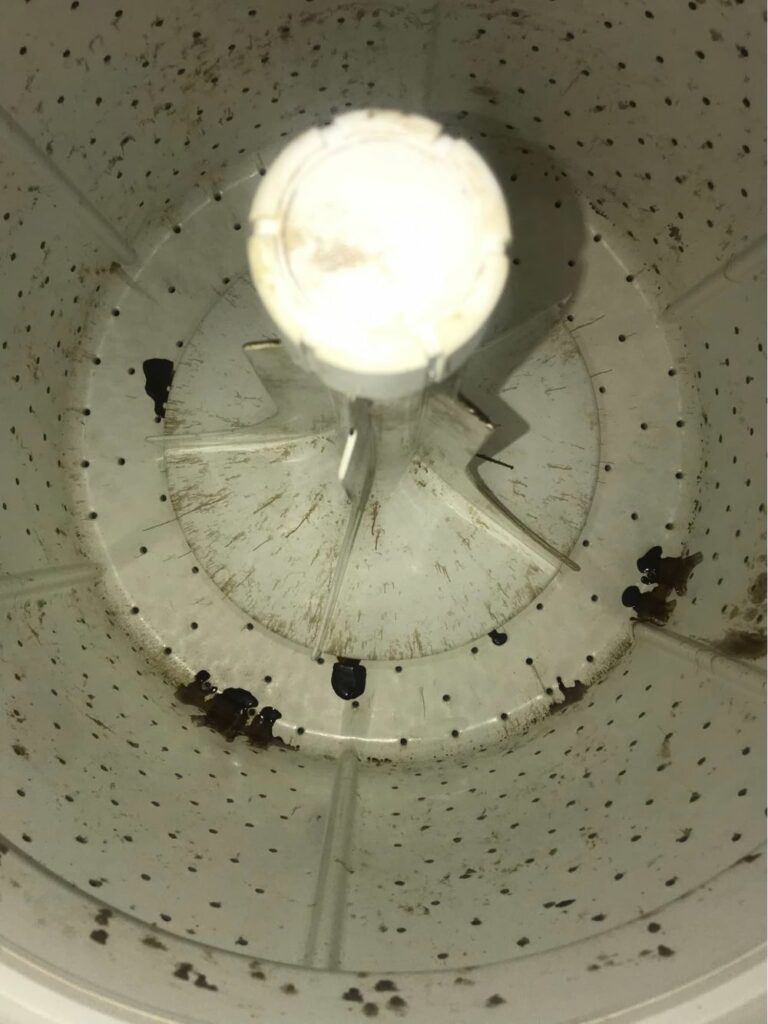
Solution:
To fix this problem, you will have to replace both the tub and transmission seals.
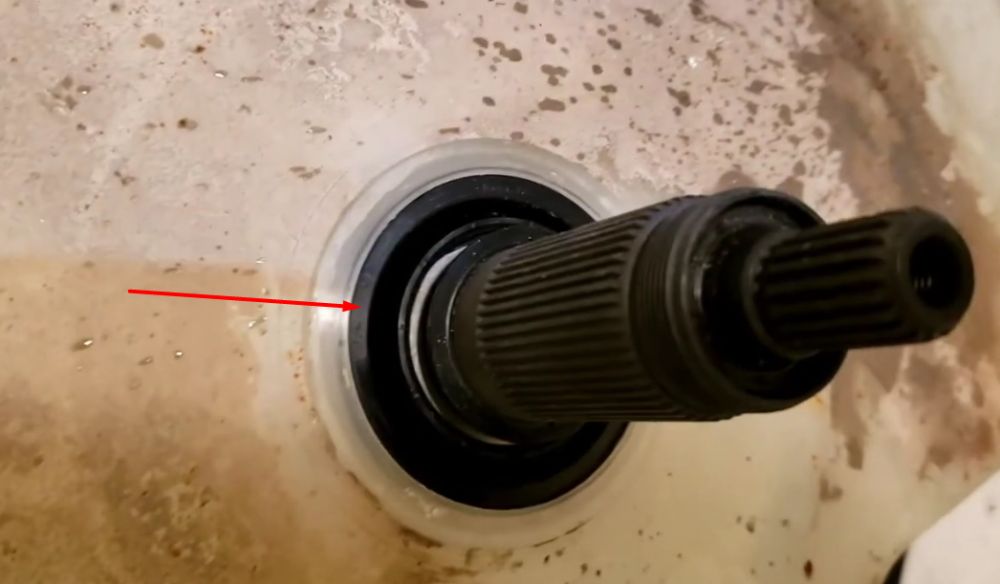
How to inspect and replace a washing machine tub seal:
- Step 1: Safety first: Disconnect power to the washer and turn off the water supplies.
- Step 2: If you have a vertical modular model, start by removing the cabinet.
- Step 3: Unscrew the agitator.
- Step 4: Use a tub nut wrench to remove the troublesome tub nut.
- Step 5: With the nut out of the way, you can removethe inner tub and the drive block.
- Step 6: Proceed to the outer tub.
To remove the tub seal, gently squeeze it and press it out.
Note:
This process may be different depending on the design and location of the seal. A good example is the GE #38372 washer.
The process is also different with Kenmore, Whirlpool, or Maytag washers boasting a pulsator
- Step 7: Install the new tub seal.
- Step 8: Put everything back together.
- Step 9: Run a test cycle.
Why Is My Washer Leaking Oil and Making Noise?
Now:
What about a washer that’s not just spilling oil but also being vocal about it?
As Ian explains,“An oil leak, especially if it has been going on for some time undetected, can be accompanied by noises.”
Now:
The noise usually occurs when the oil drips on components such as the drive belt and splutch cam.
1. Drive Belt
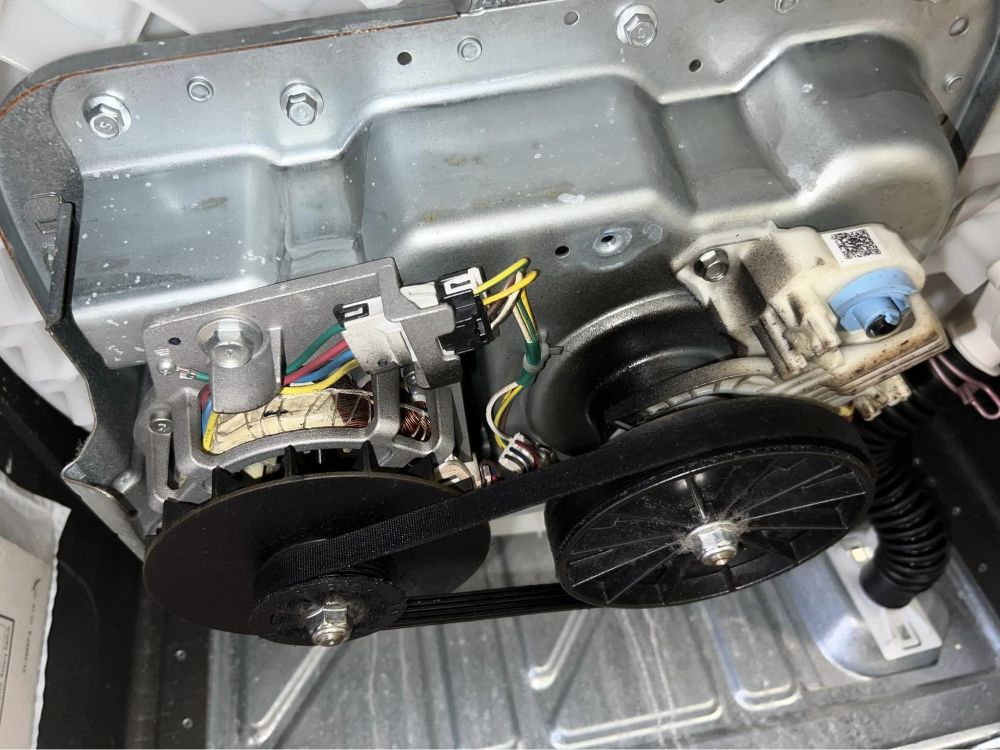
Now:
If transmission oil drips onto the drive belt, it can reduce the belt’s grip. Result?
The belt may slip, potentially creating a screeching or squealing noise. The noise might be more pronounced when the machine starts a cycle or transitions between modes.
2. Splutch Cam
If oil gets onto the splutch cam, it could cause it to slip or not engage fully.
Also, an oil-soaked splutch cam might produce a grinding noise or a clicking sound when the washer is transitioning between agitation and spin modes.
3. Shift Actuator
If oil leaks onto the shift actuator, it could cause incomplete shifts or cause it to stick in one mode. The washer may also produce a whirring or humming sound, especially if it’s struggling to move the splutch cam.
Also:
You might hear a repeated clicking sound if the actuator is attempting to shift but is unable to.
Now:
Once you’ve identified where the noise is coming from, it’s time to clean. Wipe off oil from every component below the transmission. If there is a defective component, replace it.
Note:
Sometimes, the noise could be coming from a completely different component. In such a scenario, you will need to do thorough troubleshooting to identify the source.
Some of the common noise culprits include:
- Tub bearings,
- Suspension rods,
- Worn-out motor coupler,
- Defective clutch, and
- Drive pulley
Other times:
The noise could be coming from the transmission itself, especially if it has lost a lot of oil.
Washing Machine Leaking a Mixture of Water and Grease
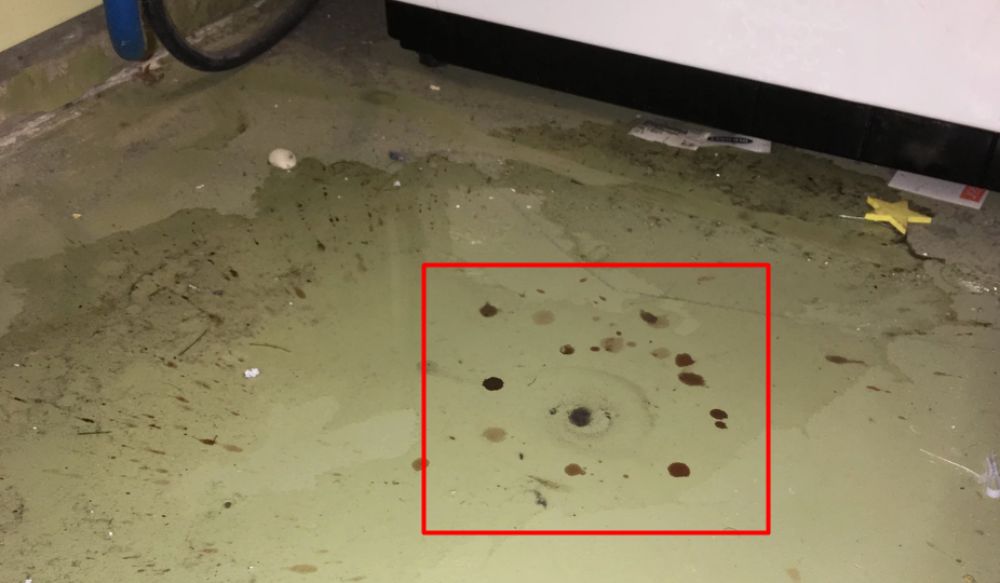
Now:
When a washer is leaking a mixture of water and grease, it’s another multiple-point failure. This problem is usually caused by a worn-out tub seal and faulty outer bearings
Now:
The tub bearings allow the drum or agitator to spin smoothly and are typically lubricated with grease to reduce friction. If these bearings fail, the grease may be pushed out.
According to Ian,“Grease leaks mostly happen during hot cycles, when it becomes less dense and runnier.”
Now:
To inspect or replace the tub bearing, you will have to disassemble the whole washer and remove both tubs. The tub bearings are usually located at the bottom of the outer tub.
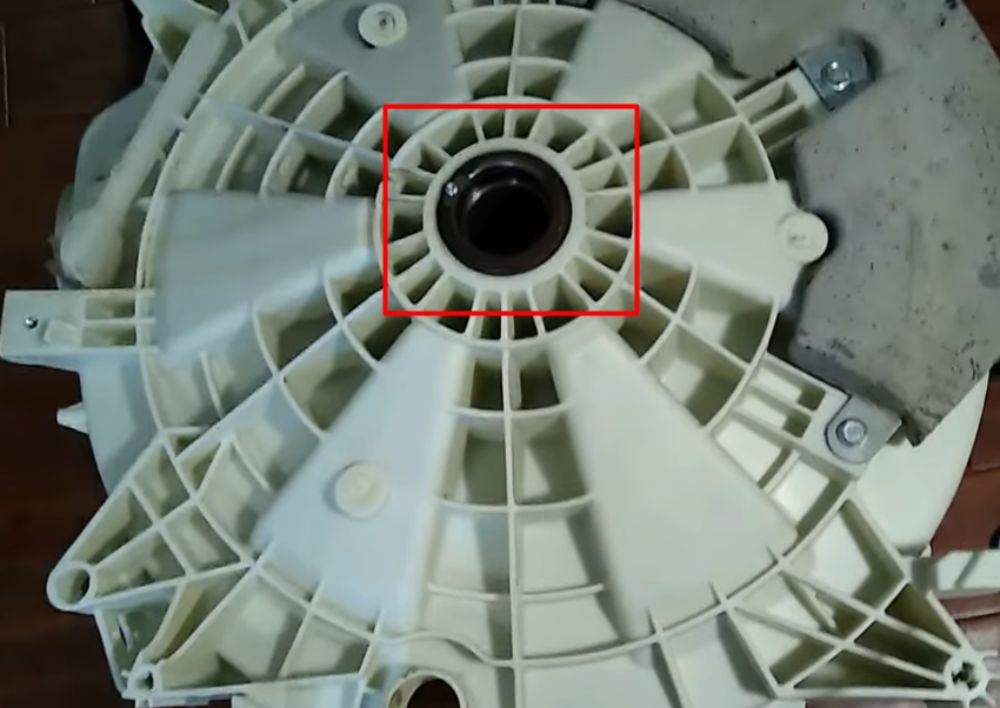
Note:
There are some brands that don’t sell replacement tub bearings. Instead, the bearings are sold with the inner tub.
And let me tell you, the package isn’t cheap. In such a situation, you’re better off considering a new washer and, if you have the know-how, fixing the bearings yourself.
Washing Machine Transmission Warranty
Now:
Before proceeding with disassembling your washer, check your warranty to see if the transmission is covered. If you are lucky and yours is covered, reach out to the brand.
Here is a table comparing transmission warranties across washer brands.
| Brand | Transmission warranty |
|---|---|
| Speed Queen | 15 years |
| Whirlpool | Most models have a 5-year gear case warranty |
| Maytag | Some models have a 5- or 10-year transmission warranty Such as LAT8826AAE MVWX655DW1 |
| GE | Some models have a 10-year transmission warranty |
| LG | 1-year warranty |
| Kenmore | 1-year warranty Some models have a 5-year transmission warranty |
| Amana | Most models have a 5-year gear case warranty |
Here’s another trick from Ian: “If you are lucky and your transmission is under warranty, request the brand to send the transmission without a service tech.”
Why?
Brand-authorized technicians are usually expensive, and the financial implications won’t make sense. Luckily, it’s easy to replace.
Conclusion
Alright, folks, let’s sum it up:
When a washer is leaking oil from the bottom, it is usually from the transmission. Why? Because it’s the only component that has oil in it.
Most of the time, the leak occurs because of a worn-out transmission oil seal.
Good news? You can replace it.
When oil escapes from the transmission, it drips on the components below it, such as the drive belt, shift actuator, and pulleys.
The drive belt then splashes it on the body. The belt may also start slipping off the pulley, leading to a squeaking noise.
Note:
If the transmission has lost a significant amount of oil, you will need to top it up. You can also choose to replace the entire transmission; however, it might not be worth the cost.
If you have a question or comment, leave it in the section below or post it in our free Facebook group.

